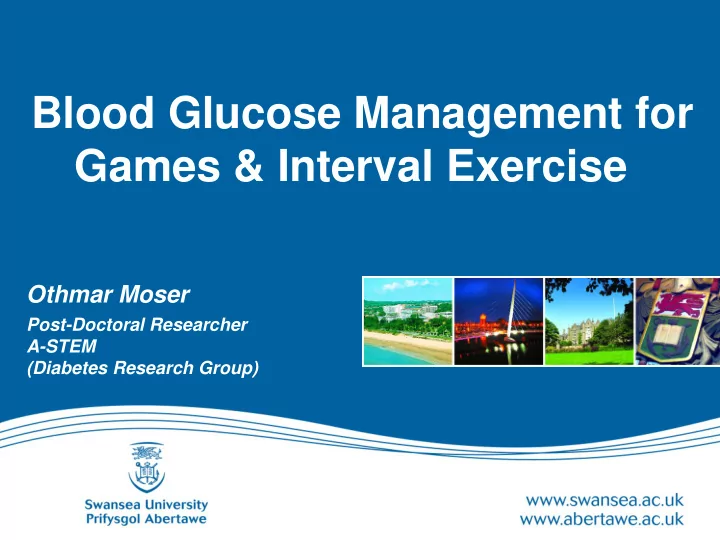

Blood Glucose Management for Games & Interval Exercise Othmar Moser Post-Doctoral Researcher A-STEM (Diabetes Research Group)
Table of Content • Games & Interval Exercise – different or the same? • Safe for People with Type 1 diabetes? • Therapy Management around Games & Interval Exercise • Expected Glucose Responses • New Technology/Insulin and Games & Interval Exercise
Games & Interval Exercise – different or the same? Basketball Game Interval exercise Random order Structured Games & interval exercise describe physical exercise that is characterised by brief, intermittent bursts of vigorous activity ( O ), interspersed by periods of rest or low-intensity exercise ( O ). Matthew et al., 2009 Cipryan et al., 2017 Gibala e al., 2012
Safe for People with Type 1 diabetes? • Games and interval exercise can be associated with a YES ! higher risk of nocturnal hypoglycaemia than continuous aerobic exercise • No data exist on increased risk of cardiovascular events (e.g. myocardial infarction) during interval exercise in people with type 1 diabetes • Even in patients with coronary heart disease, an event rate of 1 nonfatal heart attack per 23182 hours of interval training it is reported Moser et al., 2015 Riddell et al., 2017 Rognmo et al., 2012
Therapy Management around Games & Interval Exercise Intensity 30 min exercise 60 min exercise Low 1 - 25% for bolus insulin (60-90 min - 50% prior exercise) Moderate - 50% - 75% Heavy - 75% NA Intense - 75% NA 1 Low = fast walking, jogging (easily talking) Moderate = fast jogging, moderate running (talking possible) Heavy = fast running (talking demanding) Riddell et al., 2017 Intense = fast running (talking not possible) Moser et al., 2017 Moser et al., 2015
Therapy Management around Games & Interval Exercise Starting blood glucose below 5 mmol/L (<90 mg/dL) • Ingest 10 – 20 g of glucose before starting exercise; delay exercise 5 – 6.9 mmol/L (90 – 124 mg/dL) • Games & interval Exercise can be started 7 – 10 mmol/L (126 – 180 mg/dL) & 10.1 – 15 mmol/L (182 – 270 mg/dL) • Games & interval Exercise can be started; blood glucose could rise Above 15 mmol/L (270 mg/dL) • NO games & interval Exercise; check ketones! Riddell et al., 2017
Expected Glucose Responses to Games - 1.1 ± 0.7 mmol/L Game - 5.3 ± 0.4 mmol/L Continuous exercise 45 min Campbell at al., 2014
Expected Glucose Responses to Interval Exercise (20 sec Sprints) No difference in blood glucose decrease in comparison of continuous exercise and interval exercise in blood glucose response during exercise and during 24 hrs after exercise for different exercise intensities! Moser et al., 2015
New Technology/Insulin for Games & Interval Exercise Exercise INT/Games studies studies • Flash glucose monitoring • Continuous glucose monitoring • Basal-automatic artificial pancreas • Ultra-long acting insulins • Faster-short acting insulins
Reality around Games & Interval Exercise…
… but doable?
Take Home Message • Games & interval exercise are safe for people with type 1 diabetes • Therapy adaptation is mainly based on exercise intensity and duration • Adequate reaction to starting blood glucose levels are necessary • Blood glucose response to games & interval exercise may vary
Literature 1. Lukas Cipryan, et al. Acute and Post-Exercise Physiological Responses to High-Intensity Interval Training in Endurance and Sprint Athletes. J Sports Sci Med. 2017 Jun;16(2):219-229. 2. Dionne Matthew, Anne Delextrat. Heart rate, blood lactate concentration, and time – motion analysis of female basketball players during competition. Journal of Sports Sciences, June 2009; 27(8): 813 – 821. 3. Martin Gibala, et al. Physiological adaptations to low-volume, high-intensity interval training in health and disease. J Physiol 590.5 (2012) pp 1077 – 1084. 4. Othmar Moser, et al. Effects of High-Intensity Interval Exercise versus Moderate Continuous Exercise on Glucose Homeostasis and Hormone Response in Patients with Type 1 Diabetes Mellitus Using Novel Ultra-Long-Acting Insulin. PLoS ONE 10(8): e0136489. doi:10.1371/journal.pone.0136489. 5. Michael C Riddell, et al. Exercise management in type 1 diabetes: a consensus statement. Lancet Endocrinology. 2017 http://dx.doi.org/10.1016/S2213-8587(17)30014-1. 6. Rognmo Ø, et al. Cardiovascular risk of high- versus moderate-intensity aerobic exercise in coronary heart disease patients. Circulation. 2012. 126(12):1436-40. 7. Othmar Moser, et al. Short-Acting Insulin Reduction Strategies for Continuous Cycle Ergometer Exercises in Patients with Type 1 Diabetes Mellitus. Asian J Sports Med. 2017 March; 8(1):e42160. 8. Campbell, et al. Simulated games activity vs continuous running exercise: A novel comparison of the glycemic and metabolic responses in T1DM patients. Scand J Med Sci Sports 2014: doi: 10.1111/sms.12192
Dankeschön! Othmar Moser E-mail: othmar.moser@swansea.ac.uk Tel: +44 7757 062851 Web: researchgate.net/profile/Othmar_Moser Twitter: @Othmar_moser
Recommend
More recommend